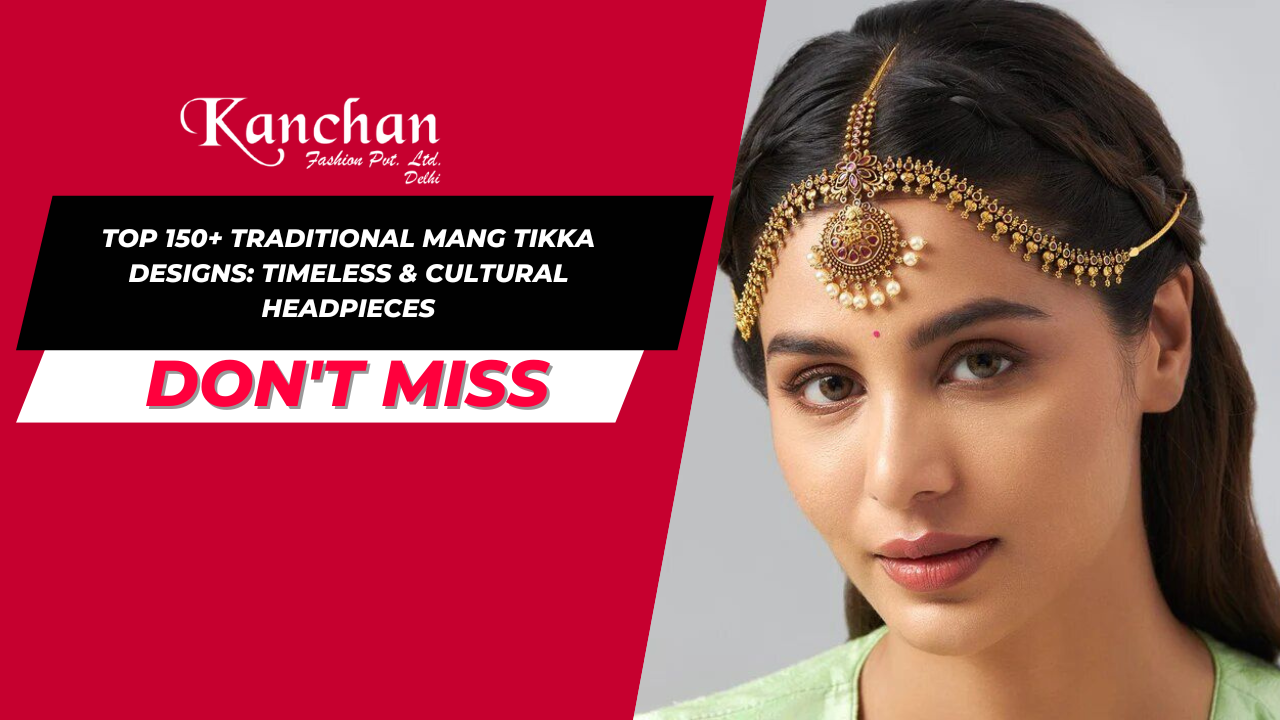
Table of Contents
- Introduction: The Enduring Allure of the Traditional Mang Tikka
- The Significance of the Mang Tikka in Indian Culture
- Exploring the Rich History of Head Ornaments
- Gold Mang Tikkas: The Epitome of Tradition and Luxury
- Silver Mang Tikkas: Elegant and Versatile Choices
- Kundan Mang Tikkas: Royal Grandeur and Intricate Craftsmanship
- Polki Mang Tikkas: Uncut Diamond Elegance with a Vintage Charm
- Meenakari Mang Tikkas: Vibrant Enamel Work Reflecting Artistic Heritage
- Pearl Mang Tikkas: Classic and Sophisticated Adornments
- Gemstone Mang Tikkas: Adding Color and Personal Meaning
- The Classic Round Mang Tikka: A Timeless Silhouette
- The Elegant Teardrop (Paisley) Mang Tikka: Grace and Femininity
- The Majestic Borla Mang Tikka: A Rajasthani Statement Piece
- The Chic Mathapatti: An Elaborate Headband-Tikka Combination
- The Subtle Side Maang Tikka (Passa/Jhoomar): Asymmetrical Beauty
- Fusion Mang Tikkas: Blending Traditional and Contemporary Styles
- Regional Variations in Mang Tikka Designs Across India
- Choosing the Right Mang Tikka for Your Face Shape and Occasion
- Caring for Your Precious Mang Tikka: Ensuring Longevity
- The Enduring Legacy of Traditional Mang Tikkas in Modern Fashion
- Conclusion: Embracing the Timeless Beauty of the Mang Tikka
- Frequently Asked Questions (FAQs)
Top 150+ Traditional Mang Tikka Designs: Timeless & Cultural Headpieces
















































































































1. Introduction: The Enduring Allure of the Traditional Mang Tikka
The Mang Tikka, a captivating piece of traditional Indian jewelry, holds a place of immense significance in the cultural and sartorial landscape of the subcontinent. More than just an ornament, it is a symbol of beauty, femininity, and marital status in many communities. Placed at the center of the forehead, where the 'ajna chakra' or the third eye is believed to reside, the Mang Tikka is thought to possess spiritual significance, representing wisdom and focus. Its presence in bridal ensembles is almost mandatory, signifying the bride's transition into a new phase of life and her auspicious beginnings. Beyond weddings, the Mang Tikka graces the foreheads of women during festivals, religious ceremonies, and other celebratory occasions, adding a touch of traditional elegance to their attire.
The sheer variety of traditional Mang Tikka designs is astounding, reflecting the diverse artistry and cultural nuances across different regions of India. From the opulent gold and Kundan creations favored in the north to the delicate pearl and gemstone pieces popular in the south, each design tells a unique story of heritage and craftsmanship. These headpieces are not mere accessories; they are heirlooms, often passed down through generations, carrying with them the blessings and traditions of the family. The intricate detailing, the choice of materials, and the overall design of a Mang Tikka speak volumes about the wearer's cultural identity and personal style. In an era of fast fashion and fleeting trends, the traditional Mang Tikka stands as a testament to enduring beauty and timeless appeal, continuing to captivate and adorn women with its exquisite charm. This blog post aims to delve into the fascinating world of traditional Mang Tikka designs, exploring their historical roots, cultural significance, diverse styles, and the reasons behind their enduring popularity. We will embark on a journey through a vast repertoire of designs, offering inspiration and insights for those seeking to embrace this iconic piece of jewelry.
2. The Significance of the Mang Tikka in Indian Culture
The Mang Tikka transcends its aesthetic appeal, deeply embedded in the cultural fabric of India. Its significance varies across different regions and communities, but certain core meanings remain consistent. Primarily, it is associated with marital status. In many North Indian traditions, the Mang Tikka is an essential part of the bridal adornment, signifying that a woman is married. The act of the groom placing the Mang Tikka on the bride's forehead during the wedding ceremony is a symbolic gesture, representing the union of two souls and the acceptance of the bride into her new family. This tradition underscores the Mang Tikka's role as a powerful symbol of commitment and belonging.
Beyond its marital connotations, the Mang Tikka holds spiritual significance. Its placement on the forehead coincides with the location of the 'ajna chakra,' considered the center of intuition and wisdom. Wearing a Mang Tikka is believed to activate this chakra, promoting mental clarity, concentration, and inner peace. In this context, the ornament is not just a decorative piece but also a spiritual amulet, warding off negative energies and bestowing blessings upon the wearer. Furthermore, the Mang Tikka is often associated with prosperity and good fortune. The materials used in its creation, such as gold and precious stones, are considered auspicious and are believed to attract positive vibrations. The intricate designs and the craftsmanship involved also symbolize the artistry and cultural heritage of the region. During festivals and religious ceremonies, women adorn themselves with Mang Tikkas as a mark of respect for tradition and as an expression of their cultural identity. The collective sight of women wearing these beautiful headpieces during such occasions reinforces a sense of community and shared heritage. The Mang Tikka, therefore, is more than just a piece of jewelry; it is a cultural emblem, a spiritual symbol, and a testament to the rich traditions of India.
3. Exploring the Rich History of Head Ornaments
The tradition of adorning the head with ornaments dates back to ancient times, with archaeological evidence and historical texts revealing the prevalence of headpieces across various civilizations. In India, the history of head ornaments is deeply intertwined with religious beliefs, social customs, and royal patronage. Ancient sculptures and paintings depict deities and royal figures adorned with elaborate headwear, suggesting that these ornaments were not only symbols of beauty but also of power and divinity. The Mang Tikka, in its various forms, has evolved over centuries, reflecting the changing artistic styles and cultural influences of different eras.
During the Mughal period, jewelry making flourished, and head ornaments became increasingly intricate and opulent. The influence of Persian and Central Asian designs can be seen in the elaborate settings and the use of precious stones like rubies, emeralds, and diamonds in Mang Tikkas of that era. Royal women wore magnificent headpieces that showcased the wealth and grandeur of the empire. The tradition of passing down these exquisite pieces through generations further solidified their importance as family heirlooms. In different regions of India, distinct styles of head ornaments developed, reflecting local materials, craftsmanship, and cultural aesthetics. For instance, the Borla of Rajasthan, with its spherical pendant, and the Mathapatti of Maharashtra, with its intricate chain extending along the hairline, are testaments to these regional variations. The materials used also varied depending on the availability and cultural significance of different metals and stones. Gold has always been considered auspicious and a symbol of prosperity, while silver was favored for its elegance and versatility. Gemstones, each with its own symbolic meaning and astrological significance, were also incorporated into head ornaments to enhance their beauty and power. The evolution of head ornaments, including the Mang Tikka, is a fascinating journey through India's rich history, showcasing the artistry, cultural values, and social customs that have shaped these timeless pieces of jewelry.
4. Gold Mang Tikkas: The Epitome of Tradition and Luxury
Gold, with its inherent luster and auspicious connotations, has always been a preferred metal for traditional Indian jewelry, and Mang Tikkas are no exception. Gold Mang Tikkas are considered the epitome of tradition and luxury, often associated with bridal wear and significant celebrations. The warm, radiant glow of gold complements the traditional attire and enhances the overall bridal look. The malleability of gold allows for intricate designs, ranging from simple and elegant pendants to elaborate and ornate pieces embellished with precious stones and enamel work.
One of the most common forms of gold Mang Tikkas features intricate filigree work, showcasing delicate patterns and fine craftsmanship. These pieces often incorporate motifs inspired by nature, such as flowers, leaves, and vines, reflecting the inherent beauty of the natural world. Another popular style involves setting precious and semi-precious stones like rubies, emeralds, and sapphires in a gold base. The contrast between the rich yellow of gold and the vibrant colors of the gemstones creates a striking and luxurious effect. Kundan work, where uncut gemstones are set in gold with thin layers of pure gold foil in between, is also a hallmark of traditional gold Mang Tikkas, lending a regal and timeless appeal. The weight and purity of the gold are often significant factors, with heavier, high-carat gold pieces being considered more valuable and auspicious. Gold Mang Tikkas are not just ornaments; they are often seen as investments and are passed down as cherished family heirlooms. Their timeless appeal ensures that they remain relevant across generations, embodying the enduring traditions and the luxurious heritage of Indian jewelry. The versatility of gold allows it to be crafted into a myriad of designs, ensuring that there is a perfect gold Mang Tikka to complement every bride and every festive occasion.
5. Silver Mang Tikkas: Elegant and Versatile Choices
While gold holds a significant place in traditional jewelry, silver Mang Tikkas offer an equally elegant and versatile alternative. Silver, with its subtle sheen and cool tones, provides a sophisticated and understated charm. Silver Mang Tikkas are often favored for their adaptability, seamlessly blending with a variety of outfits and occasions, from casual gatherings to more formal events. They are also a popular choice for those who prefer a lighter feel or have sensitivities to gold.
Traditional silver Mang Tikkas often feature intricate engravings and filigree work, showcasing the skill of the artisans. These designs can range from delicate floral patterns to more geometric and contemporary motifs. Silver is also an excellent base for incorporating other materials and techniques. For instance, silver Mang Tikkas adorned with colorful enamel work (Meenakari) are highly prized for their vibrant hues and artistic detailing. The contrast between the bright enamel and the cool silver creates a visually appealing and unique piece. Oxidized silver Mang Tikkas, with their antique and rustic finish, are also gaining popularity, offering a bohemian and ethnic touch to traditional attire. These pieces often feature tribal-inspired designs and intricate carvings. Silver is also a versatile metal for incorporating gemstones and pearls. The cool tone of silver provides a beautiful backdrop for the subtle luster of pearls and the vibrant sparkle of gemstones like turquoise, lapis lazuli, and amethyst. Silver Mang Tikkas are often more budget-friendly than their gold counterparts, making them accessible to a wider range of individuals. However, this does not compromise their elegance or cultural significance. They remain a cherished part of traditional jewelry collections, offering a blend of timeless beauty and contemporary versatility.
6. Kundan Mang Tikkas: Royal Grandeur and Intricate Craftsmanship
Kundan jewelry, renowned for its royal grandeur and intricate craftsmanship, holds a special place in traditional Indian adornment, and Kundan Mang Tikkas are no exception. This ancient technique involves setting uncut gemstones, primarily diamonds and colored stones, in a gold or silver base with thin layers of pure gold foil placed between the stones and the mount. This process not only enhances the brilliance of the stones but also creates a stunning visual effect of embedded jewels. Kundan Mang Tikkas are often associated with bridal jewelry and are highly prized for their opulent and regal appearance.
The artistry of Kundan lies in the meticulous setting of each individual stone, ensuring a seamless and flawless finish. The intricate designs often feature traditional Indian motifs, such as peacocks, floral patterns, and geometric shapes, all rendered with exceptional detail. The use of uncut stones, with their natural facets and unique character, adds to the timeless charm of Kundan jewelry. While diamonds are commonly used, Kundan Mang Tikkas also incorporate other precious and semi-precious stones like rubies, emeralds, and sapphires, adding vibrant pops of color to the design. The combination of the rich metal base, the sparkling uncut stones, and the intricate craftsmanship results in a headpiece that exudes luxury and sophistication. Kundan Mang Tikkas are not merely accessories; they are pieces of art that reflect the rich cultural heritage and the skilled artistry of Indian jewelers. They are often passed down through generations as treasured heirlooms, symbolizing tradition and familial legacy. The sheer elegance and the regal aura of Kundan Mang Tikkas make them a quintessential choice for brides who desire a touch of royal grandeur on their special day.
7. Polki Mang Tikkas: Uncut Diamond Elegance with a Vintage Charm
Polki jewelry, a close cousin of Kundan, also features uncut diamonds set in a gold or silver base. However, unlike Kundan, Polki often uses larger, flatter slices of uncut diamonds, which retain their natural shape and brilliance. This gives Polki Mang Tikkas a distinct vintage charm and an organic, earthy feel. The uncut nature of the diamonds means that each Polki piece is unique, with variations in the shape, size, and clarity of the stones adding to their individual character.
The setting of Polki diamonds typically involves encasing them in a gold foil, which enhances their natural luster and creates a beautiful contrast with the metal. Polki Mang Tikkas often feature elaborate designs, incorporating traditional Indian motifs and sometimes embellished with colored gemstones or enamel work. The overall aesthetic is one of understated elegance and timeless sophistication. Polki jewelry has a rich history, dating back to the Mughal era, and it continues to be a popular choice for those who appreciate the beauty of natural, uncut stones. The slightly rustic yet undeniably luxurious appeal of Polki Mang Tikkas makes them a perfect complement to both traditional and contemporary bridal ensembles. They exude a sense of heritage and old-world charm, making the wearer feel connected to a rich past. The brilliance of the uncut diamonds, combined with the intricate craftsmanship, ensures that Polki Mang Tikkas are cherished pieces that can be treasured for generations. Their unique character and timeless appeal make them a standout choice for those seeking a headpiece with a difference.
8. Meenakari Mang Tikkas: Vibrant Enamel Work Reflecting Artistic Heritage
Meenakari, the art of enameling or coloring the surface of metals by fusing mineral substances onto them, adds a vibrant and artistic dimension to Mang Tikka designs. Meenakari Mang Tikkas are characterized by their intricate and colorful enamel work, which often depicts floral patterns, birds, and other traditional motifs. This technique not only enhances the aesthetic appeal of the Mang Tikka but also reflects the rich artistic heritage of India, particularly Rajasthan, which is renowned for its exquisite Meenakari work.
The process of creating a Meenakari Mang Tikka involves meticulously carving or engraving designs onto the metal surface (usually gold or silver) and then filling these depressions with colored enamel. The piece is then fired at high temperatures to fuse the enamel to the metal, resulting in a durable and vibrant finish. Different regions of India have their own distinctive styles of Meenakari, characterized by specific color palettes and motifs. For instance, Jaipur is known for its vibrant red, green, and blue enameling, while Lucknow is famous for its delicate pink and green Meenakari. Meenakari Mang Tikkas can be combined with other jewelry techniques, such as Kundan or gemstone setting, to create truly unique and elaborate pieces. The interplay of the sparkling stones and the colorful enamel work adds a festive and celebratory touch to the headpiece. These Mang Tikkas are particularly popular for weddings and festivals, where their vibrant hues and intricate designs make a striking statement. Meenakari Mang Tikkas are not just beautiful ornaments; they are also miniature works of art that showcase the skill and creativity of the artisans. They embody the rich cultural traditions and the artistic finesse of Indian craftsmanship, making them cherished additions to any jewelry collection.
9. Pearl Mang Tikkas: Classic and Sophisticated Adornments
Pearls, with their timeless elegance and subtle luster, offer a classic and sophisticated option for Mang Tikka designs. Pearl Mang Tikkas exude a sense of grace and refinement, making them a versatile choice for various occasions, from weddings to formal gatherings. The natural beauty of pearls, whether they are round, teardrop, or baroque in shape, adds a touch of understated luxury to the headpiece.
Traditional pearl Mang Tikkas often feature delicate strands or clusters of pearls suspended from a central pendant made of gold, silver, or embellished with gemstones. The combination of pearls with other precious materials enhances their beauty and creates a harmonious blend of textures and shine. For instance, a gold pendant studded with diamonds and fringed with delicate pearl drops is a classic and elegant design. Similarly, a silver Mang Tikka with intricate filigree work and accents of small, lustrous pearls offers a more subtle yet equally sophisticated look. Pearl Mang Tikkas can also be combined with colored gemstones, where the soft iridescence of the pearls provides a beautiful contrast to the vibrant hues of rubies, emeralds, or sapphires. This combination adds a touch of color and individuality to the classic pearl design. The versatility of pearl Mang Tikkas allows them to complement a wide range of outfits, from traditional silk sarees to contemporary ethnic wear. Their timeless appeal ensures that they remain a cherished part of jewelry collections, transcending fleeting fashion trends. Pearl Mang Tikkas are a symbol of purity, elegance, and sophistication, making them a perfect choice for those who appreciate understated beauty and classic style.
10. Gemstone Mang Tikkas: Adding Color and Personal Meaning
Gemstone Mang Tikkas offer a wonderful opportunity to incorporate color and personal meaning into traditional headpieces. The use of various precious and semi-precious stones not only adds visual appeal but can also carry symbolic significance based on the properties and astrological associations of the stones. Gemstones like rubies, emeralds, sapphires, amethysts, and turquoise are frequently used in Mang Tikka designs, each bringing its unique hue and energy to the ornament.
Ruby Mang Tikkas, with their rich red color, symbolize love, passion, and energy, making them a popular choice for brides. Emerald Mang Tikkas, with their vibrant green, represent prosperity, growth, and harmony. Sapphire Mang Tikkas, in their deep blue hues, are associated with wisdom, loyalty, and good fortune. The use of these colored gemstones can add a personal touch to the Mang Tikka, reflecting the wearer's preferences or even astrological beliefs. Gemstone Mang Tikkas can be set in various metals, including gold and silver, and often feature intricate designs that highlight the beauty of the stones. They can be combined with other elements like pearls, Kundan work, or enamel detailing to create unique and elaborate pieces. The cut and setting of the gemstones also play a crucial role in the overall look of the Mang Tikka, with different cuts enhancing the brilliance and color of the stones in various ways. Whether it's a single statement gemstone or a cluster of colorful stones, a gemstone Mang Tikka is a beautiful way to add personality and vibrancy to traditional attire. They are cherished for their aesthetic appeal as well as the symbolic meanings and positive energies associated with the different gemstones.
11. The Classic Round Mang Tikka: A Timeless Silhouette








